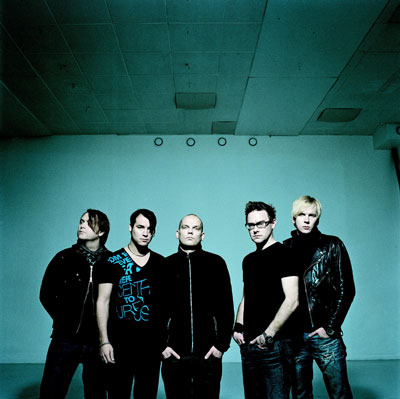Release was
invited to Kent's
studio Psykbunkern.
Since we have just
been knocked down again
by another beautifully
dark Kent album "Du
& jag döden" ("You
& Me Death"), what
else was there to do
than accept. And after
all, we're talking
about the biggest and
best of all the thousands
of bands in Sweden.
Welcome
to the black bunker
When
I’m walking around
in the idyllic suburban area
of Örby
outside of Stockholm, I find
myself thinking that it’s
a bit wild that the biggest
band in Sweden has its base
here of all places. In between
houses with nice gardens
lies the former Park Folkets
hus (town hall) that Kent
have made into a modern recording
studio, lovingly called Psykbunkern
(freely translated into “the psychotic
bunker”).
Once inside
I meet with Sami Sirviö,
resident guitar virtuoso
and as I find out, an all-round
nice guy. I’m immediately
struck by the overall black
theme in the studio.
The windows are dark, all
the doors are black, the
sofa we’re
sitting in is black... you
get the idea. They
have a really cosy relax
room in one part of the studio,
which is where we talk. It’s
equipped with some of the
essentials in life: a big
screen projector, an xbox,
a Playstation 2, a DVD player
and so on, but in preparation
for the upcoming tour, it’s
filled with transportation
boxes.
– We
really like it here, says Sami.
It’s good to get away
from the city. It was Stefan
Boman, who produced “Du
& jag döden” with
us, that knew about this place.
It used to be a music equipment
shop and Stefan had heard
that they were closing down.
So he and I got things
going, had people building
the studio, and we bought a
huge mixing desk from Japan.
Kent plan to stay in their
bunker for some
time.
– If we get
tired of recording here, we could
just go and do the basic recordings
somewhere else, and get back here
for the mix and to finish up. It’s
an economic gain as well, as we
took the recording budget for
this instead of hiring a studio
for 12 000 (Swedish kronor, about
$ 1 700) a day.
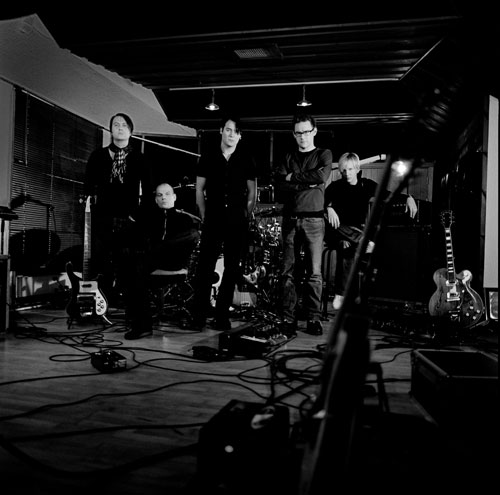
From left to right: Martin Sköld,
Harri Mänty, Markus Mustonen, Joakim
Berg and Sami Sirviö.
EP
after the summer?
For the new album,
Kent changed studio
tactics. Instead
of piecing together
tracks on the computer,
they rehearsed the songs for
three months. Around twenty
songs were rehearsed,
of which eleven
ended up on the finished product.
Kent wrote several great tracks
that didn’t
fit in. Two of them are used
on the latest single “Palace
and Main”, and Sami tells
me that they almost cried when
one of those tracks – “Nihilisten” – was
pulled from the album track
list, because it didn't
fit the flow they were trying
to create.
They also have some songs that
they didn’t have time
to complete. These may end
up on an EP at the end of the
summer, Sami tells me all this
slowly; seemingly thinking
about if he really should tell
me.
– Maybe
we’ll only release
it via Itunes. Do something
different. People think
it’s easier to
download songs, and we
understand that. So it’s
better that we find
a solution, than to
fight each other.
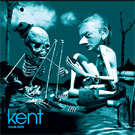
The
art of creating a
buzz
The cover art of “Du &
jag döden” is based
on a painting by Oskar Korsár.
He was introduced to the band
by Johan Renck (Stakka Bo), who
takes care of some of their stage
production. Oskar had made a
painting of a skeleton and a
girl sitting on the beach, holding
each other. Sami thought that
obviously, the image would fit
well with the theme of the album,
and asked Oskar if he could make
a painting especially for them.
Unfortunately he didn’t
have time to do it, so Johan
Renck’s production company
did it, on computers, instead.
The result has been the center
of some serious debate on Kent’s
web forum.
– We
knew there would be talk,
of course. But that’s
also the point.
Instead of having a beautiful
photo of a landscape
or an animal, we thought
that this time, we should
do something completely
different.
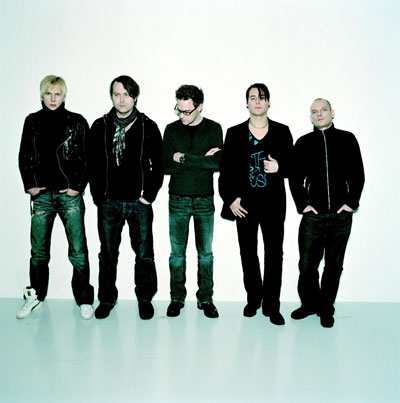
Kent
rent a tent
Just
before the time of
the interview,
Kent played Copenhagen
as a test before
the real tour
started. It went
very well, with
rave reviews,
and a building
anticipation among
the fans. The
main tour will
make use of Europe’s
biggest concert tents,
humongous beasts built
to accommodate 18 000
people at once. These
will be used at the
four shows in Stockholm
and Gothenburg, while
other cities have to
do with smaller tents.
Anna
Ternheim is going to open the
shows. She is a Swedish newcomer
Grammis winner and Kent are
pleased with having her joining
them.
Kent might go from the big
and bold, to play small club
gigs this autumn: around 20
gigs in total, in locations
with a maximum capacity of
1 000 people per venue.
– I’m more nervous
at a club gig, because it’s
so intimate and close. The big
stages are more relaxed, actually,
Sami thinks.
– It was our booking company
that came up with these tents,
and we thought it might be a really
good idea, because… well,
it’s probably going to
rain, hehe. You can do much more
with the lighting as well, because
it’s
dark around you inside. Compared
to the warm-up gigs, there will
be some new lighting equipment
that we haven’t
used before.
The set list will probably
change over time, Sami tells
me, which is good news for those,
like myself, who plan to see more
than one performance (in my case
Gothenburg and Stockholm).
– The list is actually always
the hardest part. It’s
always hell to come up with it.
We vote for songs, but then you
often realize while rehearsing
that it doesn’t
work. You have to create an even
flow, tempo-wise. You can’t
go from ballad to a fast song,
back to a ballad, and then to a
fast song again. People will
freak out. And
then you have to think about
if there are three songs with similar
intros..., well then you can’t
play them after each other, can
you?
Independence
Sami tells me that
they thought a lot about
the tents' capacity prior
to the ticket sale start.
How on earth would they
be able to fill these?
With no record out at
the time, and the possibility
of a flop when "Du &
jag döden" reached the
world, things could have
gone wrong. As usual
though, this band's steady
relationship with the
Swedes seems
to be solid. Over
100 000 tickets have
been sold, and the album
has sold over 200 000
copies in Scandinavia
so far. I prod Sami Sirviö
for some thoughts about
why Kent are able to
maintain this level of
popularity over time.
– Well, first of all, Jocke
(Joakim Berg, singer, lyricist,
main songwriter) writes damn good
songs. That’s the basis of
it all. You can’t defend
yourself from great songs. The
other main thing is that we don’t
care about what people say or think
about us. We just do what we do
until we drive off the road…
Very few bands have managed
to achieve what you have.
– Yes, but then again, you
could say “what’s so
hard?”. I’m wondering
more about what other bands do
wrong, actually. As long as you
do what you really want to do,
it’s quite simple. I think
many go wrong when they start to
change their music so that it
fits in a certain climate; like
starting to use techno elements,
just because that’s
popular at the time.
Personally,
I think the record company
is also a big part of
the success. It backs
Kent fully but at the
same time lets them
do what they want. Sami
claims the main
reason they signed to
RCA/Sony BMG was that
they were the only ones
who gave them total artistic
freedom.
– You
might expect small indie
labels to give you more
freedom, but ironically
that’s not the
case. Almost the other
way around actually,
because indie labels
try to control the sound
of their artists much
more. Independent is
not a genre, it’s
an attitude towards music.
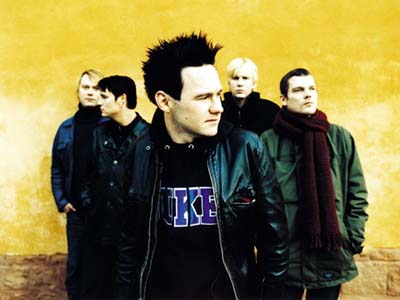
Wanted to make synthpop
with Mobile Homes
So
what are their influences
then? Sami takes the
easy road and answers “damn
good songs”,
no matter what the
genre; as long as there
is a great melody in
there somewhere.
– When
I grew up I was a total
Elvis maniac, and then
in the eighties there
was the new romantic
wave, with Indochine,
Alphaville and music
like that. And then there
was the awful metal period,
which I’m trying
to forget. I didn’t
like any of it.
But towards the end of
the eighties I discovered
Depeche Mode, around “Black
Celebration” and “Music
for the Masses”.
And The Sisters of
Mercy came along for
the ride, almost automatically.
So,
Sami likes electronic
music, but the real
fan in the band is Markus
Mustonen, a Kraftwerk-fan,
complete with a “synth” hairdo.
Sami however, likes
to play with the keyboards
in the studio, and
often try out guitar
melodies on synthesizers
first.
Moreover, he has produced
an EP – aptly titled “EP” – for
Mobile Homes. We're
of course curious about
how a guitar player
in Sweden's biggest
band ends up working
with a quite small
synthpop band, although
they have worked with
celebrities before
(like Karl Bartos).
– They
called me and asked if
I wanted to produce,
because they wanted to
make a guitar record.
But I wanted to make
an electronic album!
They wanted to make a
kind of Smashing Pumpkins
thing, and we had such
a war over this. I didn’t
know what they were doing.
I guess we found something
of middle ground on
that EP, but now I’ve
convinced them to let
go of the guitars and
focus on electronic
music, which is what
made them popular in
the first place, Sami
says as he re-positions
himself in that comfy
couch of his.
The majority of Mobile
Homes now play in the
project Sapporo ’72,
and they make poppy
electronic music in
the very narrow genre
which we can call “Kraftwerk”.
Apparently the
band is aware of the
similarity to the German
quartet and laughs
at it, says Sami with
a smile. He also says
that there’s
talk about a record
deal for Sapporo ’72,
and that the album
might be mixed in Kent’s
studio.
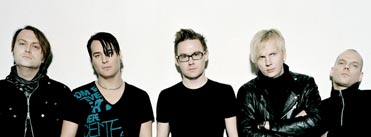
Dressed
in black
The
theme for the latest
album is death,
and the colour black is prevalent
in all the band's
imagery, especially these days.
This is to separate
it from the white-themed,
happier last album “Vapen & ammunition” that
sold over half
a million copies
in Scandinavia,
and culminated
in a concert at
Stockholm Stadium
with a huge audience
of over 30 000
totally clad in
white.
– We
didn’t expect
that so many would actually
show up in white, Sami
laughs. It was just a
joke! We were sitting
in the rehearsal studio
when the booking company
came in and we started
joking about parties
with dresscodes, and
someone said “we
should print 'dresscode:
white' on the posters!”.
Then we didn’t
really think about it
anymore, until we saw
the actual posters! When
we came on stage and
realized that everyone
actually wore white,
well… that
was the best part
of the show. We
just stood there
with open mouths
throughout the
entire concert,
wondering what
went wrong...
So, do you expect
people to show up in
black this time around?
– Hehe, that would be so
damn cool! I heard that Gyllene
Tider (another big Swedish band)
tried something like that with
red clothes, but it didn’t
work out. I guess red clothes
makes it harder. Black or
white works better, but maybe
we should try chicken yellow
or something, haha.
Skeleton in the closet
Our time is quickly running out,
but our conversation drifts towards
old synthpop favourites, and
Alphaville's concert at the Stockholm
Tinitus festival last year, where
they played a reggae version
of "Sound
Like a Melody". Sami laughs
and tells me that they were rehearsing
a reggae version of the old Kent
hit “Kräm” when
they were too fed up with it,
thus ensuring that no one would
want to hear it again. I wonder
if that was what Marian Gold
was after as well? Anyway,
luckily for us someone stopped
Kent in time.
On my way out, Sami
proudly shows me
a big skeleton given
to them by their
booking company.
It fits well with
the dark studio,
and after saying
goodbye, my eyes
hurt from the light coming
from the warm spring sun
outside. As I walk
through the calm neighborhood,
I wonder if the kids in the
nearby school know
that their idols
are just around the
corner?
Read
more
After
a failed search for a
new Skinny Puppy front
page image for our interview,
Kent was chosen for cover
story of printed Release issue
1/96. Martin Söderström
met Joakim Berg at a swimming
pool complex.
|
|
|
